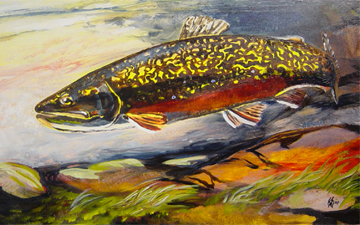The brook trout, Salvelinus fontinalis, (sometimes called the eastern brook trout) is a species of fish in the salmon family of orderSalmoniformes. In many parts of its range, it is known as the speckled trout or squaretail. A potamodromous population in Lake Superior are known as coaster trout or, simply, as coasters. Though commonly called a trout, the brook trout is actually a char, along with lake trout, bull trout, Dolly Varden and the Arctic char.
The brook trout is native to small streams, creeks, lakes, and spring ponds. Some brook trout are anadromous. It is native to a wide area of eastern North America but increasingly confined to higher elevations southward in the Appalachian Mountains to northern Georgia, Canada from the Hudson Bay basin east, the Great Lakes–Saint Lawrence system, and the upper Mississippi River drainage as far west as eastern Iowa.[2]
S. fontinalis prefers clear waters of high purity and a narrow pH range in lakes, rivers, and streams, being sensitive to poor oxygenation, pollution, and changes in pH caused by environmental effects such as acid rain. Its diverse diet includes crustaceans, frogs and other amphibians, insects,molluscs, smaller fish, and even small aquatic mammals such as voles, worms and flies. It provides food for seabirds and suffers attack by lampreys. The brook trout is a short-lived species, rarely surviving beyond four or five years in the wild.
Individuals normally spend their entire life in fresh water, but some — colloquially called “salters” or “sea run” — may spend up to three months at sea in the spring, not straying more than a few kilometres from the river mouth. The fish return upstream to spawn in the late summer or autumn. The female constructs a depression in a location in the stream bed, sometimes referred to as a “redd”, where groundwater percolates upward through the gravel. One or more males approaches the female, fertilizing the eggs as the female expresses them. The eggs are slightly denser than water. The female then buries the eggs in a small gravel mound. The eggs hatch in 95 to 100 days.
A potamodromous population of brook trout native to Lake Superior, which run into inflowing rivers to spawn, are called “coasters”. Coasters tend to be larger than most other populations of brook trout, often reaching 2 to 3 kg in size. Many coaster populations have been severely damaged by overfishing and by habitat alterations, especially by the construction of hydro-electric power dams, on their inflowing streams. In Ontario and Michigan, efforts are under way to restore and recover coaster populations.
(From Wikipedia, September 17th, 2010)
—
The brook trout’s body is elongate with an average length of 38.1-50.8 cm, is only slightly laterally compressed; the body has its greatest depth at or in front of the origin of the dorsal fin (Scott and Crossman, 1985). Another physical characteristic of the brook trout is an adipose fin and a caudal fin that is slightly forked (Hubbs and Lagler, 1949). Brook trout have 10-14 principle dorsal rays, 9-13 principle anal rays, 8-10 pelvic rays, and 11-14 pectoral rays (Scott and Crossman, 1985). The brook trout also has a large terminal mouth with breeding males developing a hook or kype on the front of the lower jaw (Scott and Crossman, 1985).
The coloration of the brook trout is very distinct and can be spectacular. The back of the brook trout is dark olive-green to dark brown, sometimes almost black, the sides are lighter and become silvery white ventrally (Scott and Crossman, 1985). On the back and top of the head there are wormy cream colored wavy lines known as vermiculations which break up into spots on the side (Scott and Crossman, 1985). In addition to the pale spots on the side there are smaller more discrete red spots with bluish halos (Scott and Crossman 1985). The fins of the brook trout are also distinct; the dorsal fin has heavy black wavy lines, the caudal fin has black lines, the anal, pelvic and pectoral fins have white edges followed by black and then reddish coloration (Scott and Crossman, 1985). (Hubbs and Lagler, 1949; Scott and Crossman, 1985)
The food habits of brook trout vary according to their age and life history stage. As fry, or very young fish, brook trout feed primarily on immature stages of aquatic insects (Everhart, 1961). In general a brook trout’s diet can be likened to a smorgasbord of organisms with prey ranging from Ephemeroptera to Caudata(Wittman, 2001). A brook trout will virtually eat anything its mouth will accommodate, including mostly many aquatic insect larvae such as Trichoptera, mayflies, Chironomidae, and Simuliidae. Other organisms consumed include worms, leeches, crustaceans, terrestrial insects, spiders, mollusks, a number of other fish species (cannibalism is limited to spawning time and spring), frogs, salamanders, snakes and even small mammals like voles (e.g. Microtus,Cleithrionomys), should they find one in the water (Scott and Crossman, 1985). As brook trout become larger their diet shifts more towards a piscovourus one (Everhart, 1961). Sea-run brook trout eat fish and intertebrates that are commonly found in marine environments (Scott and Crossman, 1985). (Everhart, 1961; Scott and Crossman, 1985; Wittman, 2001)
(From EOL via ADW, September 17th, 2010)




